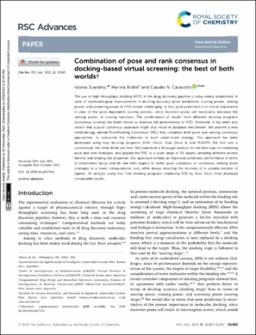| dc.contributor.author | Cavasotto, Claudio. | |
| dc.contributor.author | Scardino, Valeria. | |
| dc.contributor.author | Bollini, Mariela. | |
| dc.date.accessioned | 2023-05-29T15:38:13Z | |
| dc.date.available | 2023-05-29T15:38:13Z | |
| dc.date.issued | 2021-11 | |
| dc.identifier.citation | RSC Adv . 2021 Nov 2;11(56):35383-35391 | es |
| dc.identifier.issn | 2046-2069 | |
| dc.identifier.uri | https://riu.austral.edu.ar/handle/123456789/2169 | |
| dc.identifier.uri | https://pubs.rsc.org/en/content/articlelanding/2021/RA/D1RA05785E | |
| dc.description | Disponible en: https://pubs.rsc.org/en/content/articlelanding/2021/RA/D1RA05785E | es |
| dc.description.abstract | Abstract
The use of high-throughput docking (HTD) in the drug discovery pipeline is today widely established. In spite of methodological improvements in docking accuracy (pose prediction), scoring power, ranking power, and screening power in HTD remain challenging. In fact, pose prediction is of critical importance in view of the pose-dependent scoring process, since incorrect poses will necessarily decrease the ranking power of scoring functions. The combination of results from different docking programs (consensus scoring) has been shown to improve the performance of HTD. Moreover, it has been also shown that a pose consensus approach might also result in database enrichment. We present a new methodology named Pose/Ranking Consensus (PRC) that combines both pose and ranking consensus approaches, to overcome the limitations of each stand-alone strategy. This approach has been developed using four docking programs (ICM, rDock, Auto Dock 4, and PLANTS; the first one is commercial, the other three are free). We undertook a thorough analysis for the best way of combining pose and rank strategies, and applied the PRC to a wide range of 34 targets sampling different protein families and binding site properties. Our approach exhibits an improved systematic performance in terms of enrichment factor and hit rate with respect to either pose consensus or consensus ranking alone strategies at a lower computational cost, while always ensuring the recovery of a suitable number of ligands. An analysis using four free docking programs (replacing ICM by Auto Dock Vina) displayed comparable results.
This journal is © The Royal Society of Chemistry. | es |
| dc.language.iso | en | es |
| dc.publisher | Royal Society of Chemistry | es |
| dc.rights | Attribution-NonCommercial-NoDerivatives 4.0 Internacional | * |
| dc.rights.uri | http://creativecommons.org/licenses/by-nc-nd/4.0/ | * |
| dc.subject | Combination of pose. | es |
| dc.subject | Rank consensus in docking-based virtual screening. | es |
| dc.title | Combination of pose and rank consensus in docking-based virtual screening: the best of both worlds | es |
| dc.type | Article | es |


